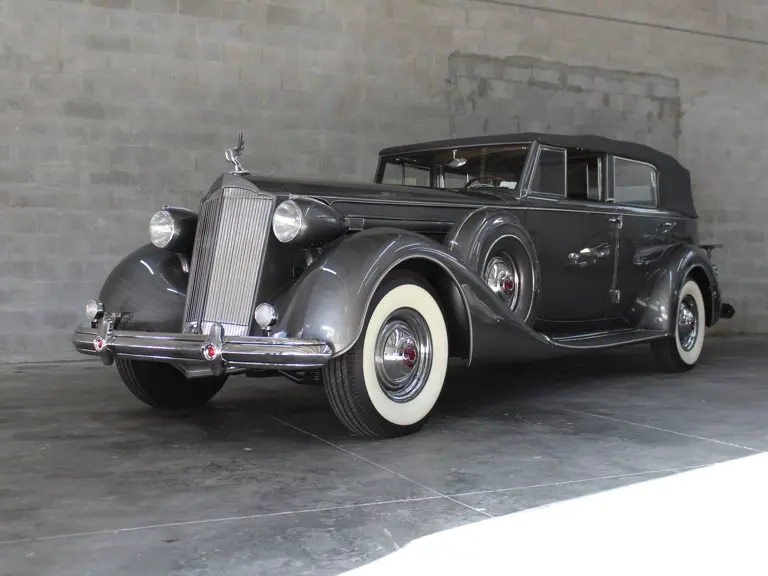
1937 Packard 1508 Twelve Convertible Sedan
{{lr.item.text}}
$206,800 USD | Sold
Model 1508
{{bidding.lot.reserveStatusFormatted}}
- 473.3-cid, 175-hp V-12 engine
- Three-speed manual transmission
- Beautiful restoration
- Pristine chrome
- "Paint is perfect"
- Dual sidemounts with covers
- Bustleback-type trunk
- Luggage rack
- Center divider window
- Mascot on radiator
- Woodgrain dash
- AM radio
- Only 1,300 Packard Twelves built in 1937
By the 1930s, the Packard Motor Car Company already possessed a wealth of experience with 12-cylinder engines. Their first, the Twin Six from 1916 to 1923, had become almost synonymous with the genre and was phased out in favor of the simpler and more advanced Single Eight that was introduced in 1924. While the Single Eight set new standards for smoothness and agility during the late 1920s, the rekindled multi-cylinder wars had resumed in earnest by the onset of the 1930s in Detroit. Cadillac introduced its V-16 in 1930 and its V-12 in 1931, while Auburn, Marmon, Pierce-Arrow, and even Franklin had their own 12-cylinder engines in the wings for 1932.
Resurrecting the “Twin Six” name, Packard met this new competitive threat with a completely new engine. With a large displacement V-12 design with a 67-degree cylinder-bank angle, development of this new power unit was the happy by-product of an aborted front-wheel drive development project. As released, the new Twelve initially displaced 445 cubic inches, 20 more than the old Twin Six, and developed 75 percent more power. In 1933, the model name was simplified to “Packard Twelve,” and two years later, engine displacement rose to 473 cubic inches and output accordingly climbed to 175 brake horsepower.
Overall, the Packard Twelve was a conservative car with finely tailored lines, elegant appointments, a refined chassis, and a whisper-quiet 12-cylinder engine. The all-new bodies that were introduced for 1935 offered true envelope styling, as the body, hood, fenders and running boards were incorporated into a smooth design. In addition, increased horsepower and improvements in suspension and steering, along with improved engine mounts, provided ease of operation and dramatically improved passenger comfort.
While the 1936 models were virtually unchanged, the 15th series of 1937 brought a comprehensive series of mechanical improvements. Most notably, the introduction of “Safe-T-Flex” independent front suspension, based on the sound design of the junior One-Twenty, debuted on the “Senior” Packard models. Other improvements included the adoption of hydraulic brakes and disc-type steel wheels and the elimination of the Bijur central chassis lubrication system.
Offered here is the 1508 (144.25-inch wheelbase) Convertible Sedan, which represents Packard’s largest and most expensive production-bodied offering of 1937. The cowl tag shows this car being sent to Eastman Motors, Inc. in Stamford, Connecticut on April 30, 1937. This Fifteenth Series Packard has the model 1073 Five-Passenger Convertible Sedan body, and it has been restored in beautiful manner. Among the desirable equipment on this Packard are dual side-mounted spares with covers, bustleback-type trunk, luggage rack, skirted fenders, distinctive vee’d radiator shell, mascot, bullet-shaped lights, cabin divider window, woodgrain dash and accents with Art Deco inspired details. The original owner’s manual accompanies the Packard; the car is reported as having a beautiful restoration with “perfect paint,” excellent interior and pristine chrome.
In the 1937 model year, amongst the 13 body styles of Packard Twelves, only 1,300 cars were built, illustrating the uncommon status this car enjoys. In the period this car was first sold, whenever America’s first families came together, Packard was the overwhelming choice of transportation. As an illustration of Packard’s dominance of the era; they accounted for nearly half of all the large fine cars sold in America. The 1508 Packard Twelve is recognized as a Full Classic by the Classic Car Club of America.


 | Fort Lauderdale, Florida
| Fort Lauderdale, Florida


